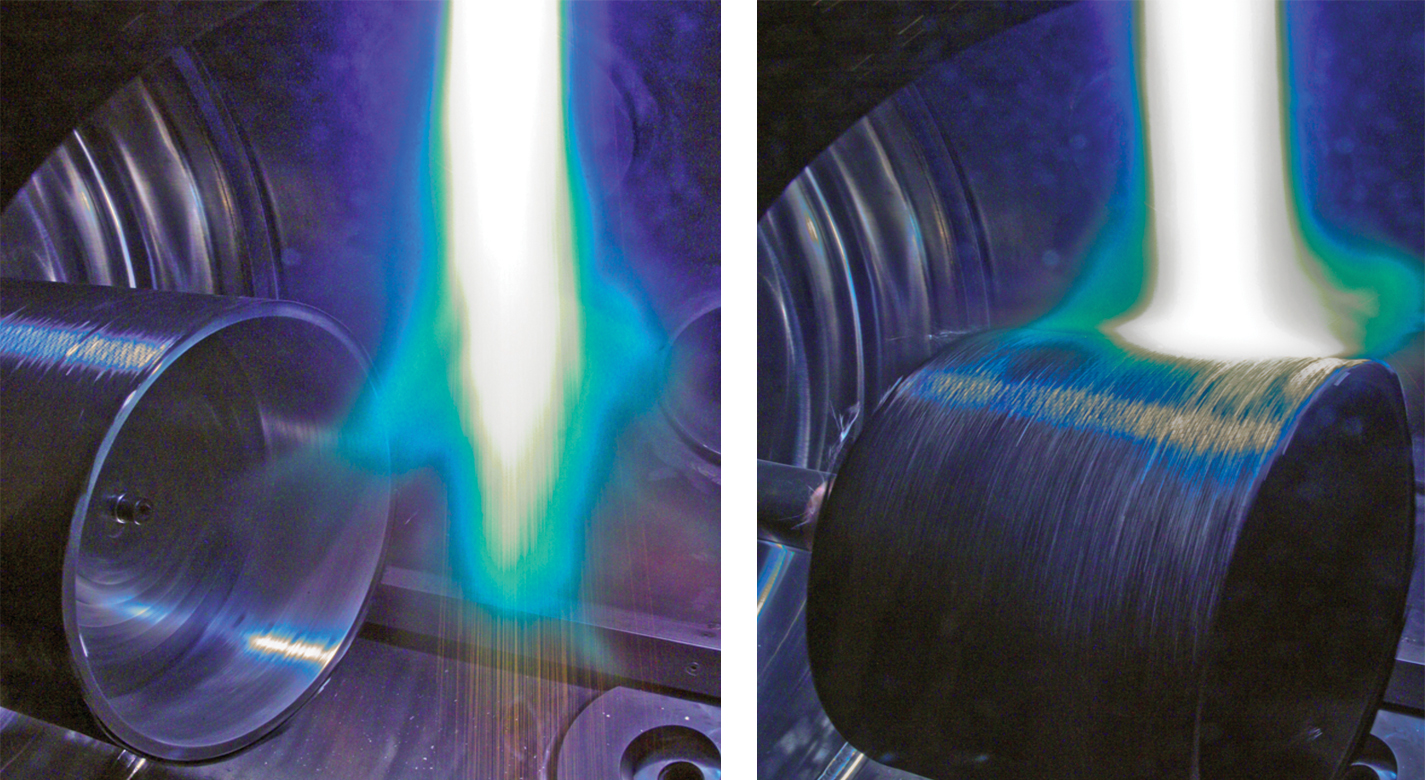Plasma Deposition of Metal in Composite Panels
manufacturing
Plasma Deposition of Metal in Composite Panels (LAR-TOPS-99)
Processing enables functional design using metals in composites
Overview
NASA's Langley Research Center has developed a new technique to enable the preparation of metal/composite hybrid laminates, also known as fiber metal laminates (FML), by depositing metal directly onto fabric using a plasma deposition process. FMLs provide a useful combination of structural and
functional properties for both aerospace and non-aerospace applications. Currently, FMLs are prepared in a compression process utilizing a press or autoclave with metallic layers (foils) sandwiched between layers of glass or graphite prepreg (preimpregnated fibers with a matrix resin). The NASA process deposits the metal on the fiber via plasma deposition. The porosity of the coated fabric allows for resin infusion.
The Technology
NASA's plasma-deposition process provides the ability to tailor various properties while designing functional parts by selecting specific materials and processing parameters to meet the end goal. Specifically, the plasma process deposits metal particles that are heated as they travel axially at low velocity through an inert gas plasma. The accelerated powder particles become molten, strike the substrate fabric (uniaxial, biaxial, and multiaxial) and rapidly solidify, imparting very little heat to the substrate while forming a metal-to-fiber bond, as well as a metal-to-metal bond. The resulting metal-coated fabric is porous, so the polymer matrix can pass through the product precursor during the infusion process. The amount of metal deposited can be
controlled, as can the number of plies of fabric that are ultimately stacked to produce the preform for the polymer matrix infusion process. A variety of infusion processes can be utilized to prepare the FML, including resin transfer molding (RTM), resin film infusion (RFI), and vacuum-assisted resin transfer molding (VARTM). The tailorable aspect of the process allows for specific product design. By varying the combination of metal particle, fiber, fabric type, metal layer thickness, fabric direction, number of layers, polymer matrix resin, infusion process, and cure conditions, the characteristics of the final part can meet the needs of various applications.


Benefits
- Metal deposition directly onto fabric eliminates the need for separate foils and provides a better interlayer bonding
- Porosity of coated fabric still allows for resin infusion and improved quality
- Metal provides textured surface for improved matrix bonding
- Variety of fabrics and metal alloys (e.g., aluminum, titanium, copper, glass fabric, carbon fabric, epoxy, polyimide) can be used to meet application requirements
- Tailorable process with flexibility in terms of resin pathways (size, pattern) and finished parts (thickness, texture, permeability, single or multi-sided, etc.)
- Final laminate products can vary in terms of stacking sequences, number of plies, metal/composite ratios, and fabric perform types
Applications
- Aeronautics and aerospace - e.g., functional materials such as embedded lightning strike protection for aircraft, and structural applications such a fuselage skins, leading-edge wings, floors and liners, pressure bulkheads, landing gear doors, flap skins, and blast-resistant cargo containers
- Pressure vessels and storage tanks
- Ballistic protection
- Automotive structures
- Composite doors and windows
Technology Details
manufacturing
LAR-TOPS-99
LAR-17485-1
FIBER METAL LAMINATES MADE BY THE VARTM PROCESS. B. J. Jensen, R. J. Cano, S. J. Hales, J. A. Alexa, E. S. Weiser1, A. C. Loos and, W. S. Johnson. ICCM-17 17th International Conference on Composite Materials, July 27-31, 2009. https://ntrs.nasa.gov/citations/20090028660
|
Tags:
|
Similar Results

Fabrication of Fiber-Metal Laminates with Non-Autoclave Processes
The FMLs resulting from the NASA process have similar properties to traditionally produced metal/composite hybrid laminates including, as compared to either the composite or metal only structures, improved load carrying capability, lighter weight, improved stiffness, improved impact resistance and damage tolerance, and improved permeation resistance. The NASA process can be applied to various FML types, including GLARE (glass, aluminum, epoxy), and TIGR (titanium, graphite). Typical manufacturing processes are costly and complex shapes are hard to produce, whereby the NASA process enables use of these kinds of laminates without an autoclave or press, thus increasing the size that can be produced and decreasing the cost.
The resin pathways in the foils enable connection between the plies that can improve the interlaminar strength of the final part. Functionally the NASA process creates resin columns in the transverse direction of the plies. NASA is working to optimize the final properties by varying the size and distribution of the pathways.

Advanced Isothermally Produced Next-Gen Composites
Next generation aircraft are anticipated to be largely made with composite components, requiring significant increases in manufacturing rates of composites to meet the demand for a new fleet of aircraft. The higher rate manufacturing will require multiple advances, including rapid curing and lower processing temperatures. These requirements can be enabled by new processing methods such as isothermal rapidly cured composite parts.
NASA has developed materials and methods that meet those stringent requirements for high-rate manufacturing. The innovators have demonstrated at least two families of new resin formulations that meet the expected high-rate manufacturing needs. These new formulations have been engineered to be infused and cured at the same (i.e., isothermal) temperature, below that of commercially available materials. The materials can then be removed from the mold while still hot without distorting the shape, thereby reducing the processing times by eliminating the need for cooling to occur in the mold. After a post-cure process - which takes 4 hours or less and can be performed in batches - the mechanical properties of NASA's next-gen composites.
The related patent is now available to license. Please note that NASA does not manufacturer products itself for commercial sale.

Automated Tow/Tape Placement System
This NASA invention enables several benefits that mitigate limitations associated with conventional ATP systems, including the following: (1) avoids obtuse head rotation or cross-tool translation when laying adjunct tape plies, (2) simultaneously places tape on both sides of a part via two robots, (3) eliminates external anchoring frame requirements, and (4) translates parts during build while also translating the applicator head. The ability to perform simultaneous layup on opposite sides of the component, as well as reduction of head rotation reversal during bidirectional tape layup, offers increased layup speed. The invention offers increased placement accuracy as a result of reduced movement between tape layup operations and the eliminated need for an anchoring frame (facilitated by simultaneous pressure extrusion of prepreg by the two robots).
NASA’s automated tow/tape placement system has two key unique features: the use of two opposed ATP cars to enable a tool-less process, and an on-the-fly reversal tape/tow laydown tooling head. The system uses two opposing (i.e., underside-to-underside) ATP cars, and can build parts vertically, horizontally, or at any other angle, depending on the workspace available. The ATP die wheels can be reversed or turned to draw the composite back and forth at different angles to create a layer-by-layer composite structure. Both cars can dispense TPC tape – thus, either car can function as an opposing tool surface while the other performs prepreg lay-up. For structures that do not vary in thickness, both cars can lay tape at the same time – doubling layup speed. Current ATP robots must rotate the large tooling head, or traverse panels without layering tape to achieve bidirectional layup, where each additional movement introduces alignment error. To increase layup rate while simultaneously minimizing misalignment, NASA’s system incorporates an on-the-fly reversal tape/tow laydown tooling head to enable efficient bidirectional layup.

Atomic Number (Z)-Grade Radiation Shields from Fiber Metal Laminates
This technology is a flexible, lighter weight radiation shield made from hybrid carbon/metal fabric and based on the Z-grading method of layering metal materials of differing atomic numbers to provide radiation protection for protons, electrons, and x-rays. To create this material, a high density metal is plasma spray-coated to carbon fiber. Another metal with less density is then plasma spray-coated, followed by another, and so on, until the material with the appropriate shielding properties is formed. Resins can be added to the material to provide structural adhesion, reducing the need for mechanical bonding. This material is amenable to molding and could be used to build custom radiation shielding to protect cabling and electronics in situations where traditional metal shielding is difficult to place.

Continuous Fiber Composite for Use in Gears
Designers are constantly seeking to improve the power-to-weight ratio of components in rotorcraft and other flight vehicles. One approach has involved using lightweight carbon fiber composite materials to replace gear web portions and other components that are typically made from steel. The problem with using fiber composite materials comes when more complex shapes are required. To create thickness variation and other accommodations for complex shapes, manufacturers can stack cut continuous fiber plies and/or form short, fiber-reinforced composite material to the desired shape. Unfortunately, these methods leave cut fiber ends within the structure, which often become initial sites for high cycle fatigue damage in high speed, high power density applications. Glenn's new method tackles this problem with one of three approaches. The first approach is applicable to gears that are planar in shape and have a single hub and a single rim. The hub and web sections of the gear are made as an integrated structure with decreased thickness from the hub inner diameter to the web outer diameter. The thickness variation is accomplished using multiple layers of continuous fiber composite material formed to specific shapes and separated by filler materials. The second approach is applicable to gears that have an extended gear body in the axial direction rather than a simple planar structure. In this approach, the gear body is made using multiple layers of continuous fiber composite material in the shape of a solid of revolution. The third approach is a power transfer assembly made by combining approaches one and two. With any of these three approaches, the material can be tailored to the structure by the properties of fibers used, the number of fiber layers used, and the location of the fibers relative to the neutral axis of the structure. Glenn's innovation opens the door for carbon fiber composite materials to be used for many applications for which they were previously unsuited.



